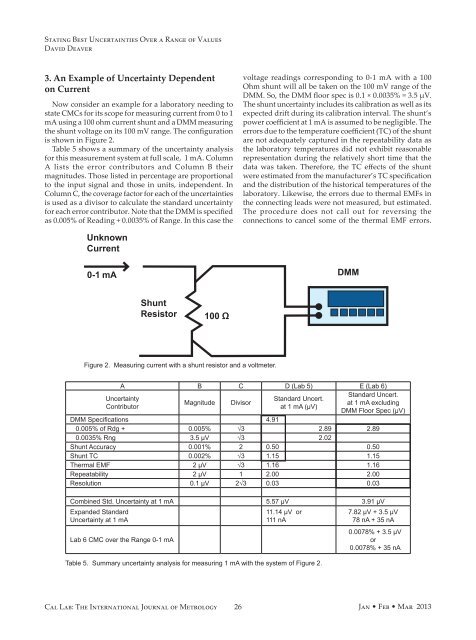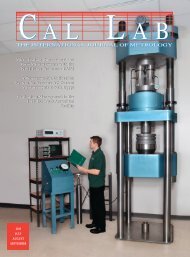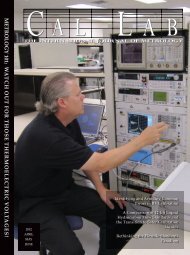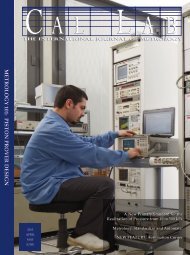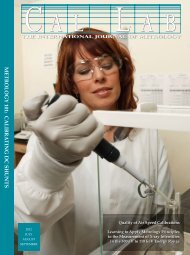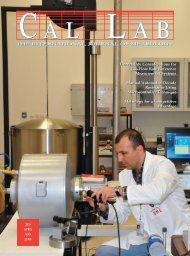Stating Best Uncertainties Over a Range of ValuesDavid Deaver3. An Example of Uncertainty Dependenton CurrentNow consider an example for a laboratory needing tostate CMCs for its scope for measuring current from 0 to 1mA using a 100 ohm current shunt and a DMM measuringthe shunt voltage on its 100 mV range. The configurationis shown in Figure 2.Table 5 shows a summary of the uncertainty analysisfor this measurement system at full scale, 1 mA. ColumnA lists the error contributors and Column B theirmagnitudes. Those listed in percentage are proportionalto the input signal and those in units, independent. InColumn C, the coverage factor for each of the uncertaintiesis used as a divisor to calculate the standard uncertaintyfor each error contributor. Note that the DMM is specifiedas 0.005% of Reading + 0.0035% of Range. In this case thevoltage readings corresponding to 0-1 mA with a 100Ohm shunt will all be taken on the 100 mV range of theDMM. So, the DMM floor spec is 0.1 × 0.0035% = 3.5 μV.The shunt uncertainty includes its calibration as well as itsexpected drift during its calibration interval. The shunt’spower coefficient at 1 mA is assumed to be negligible. Theerrors due to the temperature coefficient (TC) of the shuntare not adequately captured in the repeatability data asthe laboratory temperatures did not exhibit reasonablerepresentation during the relatively short time that thedata was taken. Therefore, the TC effects of the shuntwere estimated from the manufacturer’s TC specificationand the distribution of the historical temperatures of thelaboratory. Likewise, the errors due to thermal EMFs inthe connecting leads were not measured, but estimated.The procedure does not call out for reversing theconnections to cancel some of the thermal EMF errors.UnknownCurrent0-1 mADMMShuntResistor100 ΩFigure 2. Measuring current with a shunt resistor and a voltmeter.A B C D (<strong>Lab</strong> 5) E (<strong>Lab</strong> 6)UncertaintyContributorMagnitudeDivisorStandard Uncert.at 1 mA (μV)Standard Uncert.at 1 mA excludingDMM Floor Spec (μV)DMM Specifications 4.910.005% of Rdg + 0.005% √3 2.89 2.890.0035% Rng 3.5 μV √3 2.02Shunt Accuracy 0.001% 2 0.50 0.50Shunt TC 0.002% √3 1.15 1.15Thermal EMF 2 μV √3 1.16 1.16Repeatability 2 μV 1 2.00 2.00Resolution 0.1 μV 2√3 0.03 0.03Combined Std. Uncertainty at 1 mA 5.57 μV 3.91 μVExpanded StandardUncertainty at 1 mA<strong>Lab</strong> 6 CMC over the Range 0-1 mA11.14 μV or111 nATable 5. Summary uncertainty analysis for measuring 1 mA with the system of Figure 2.7.82 μV + 3.5 μV78 nA + 35 nA0.0078% + 3.5 μVor0.0078% + 35 nA<strong>Cal</strong> <strong>Lab</strong>: The International Journal of Metrology26 Jan • Feb • Mar 2013
Stating Best Uncertainties Over a Range of ValuesDavid DeaverFifteen sets of data were taken which was deemed toresult in high enough effective degrees of freedom thata coverage factor of 2 can be used to calculate expandeduncertainty from the combined standard uncertainty.The final uncertainty is expressed in terms of currentusing the shunt resistance value (100 ohms) as thesensitivity coefficient for the units conversion. Thus,an uncertainty calculated as 0.0039% + 2 μV would beexpressed as 0.0039% + 20 nA as a final result.3.1 <strong>Lab</strong>oratory 5: Exhaustive Analysisat Every Current LevelThe uncertainty calculations for <strong>Lab</strong>oratory 5 at 1mA areshown in Column D of Table 5. The uncertainty is calculatedin consistent units of μV though the original magnitude ofthe individual uncertainties may have been expressed in%, ppm, A, mA, Ohms, and μV. To properly combine theuncertainties they must be in the same units and at the sameconfidence level.Note that the specification for the DMM should behandled as prescribed by the manufacturer. There shouldbe little allowance for creativity by the metrologist if theanalysis is based on the manufacturer’s specifications. Themetrologist can, of course, develop alternate specificationsor uncertainties based on analysis of additional data. In thiscase, <strong>Lab</strong>oratory 5 properly arithmetically adds the % ofReading (2.89 μV) and the % of Range (2.02 μV) standarduncertainties to get a DMM standard uncertainty of 4.91 μVwhich is combined by root-sum-square (RSS) with the otheruncertainties to get a combined standard uncertainty of 5.57μV. This is multiplied by a coverage factor of two whichresults in an expanded uncertainty of 11.1 μV or 111 nA whenconverted to current.For another current within the range of 0-1 mA, <strong>Lab</strong>oratory5 generates another complete uncertaintyanalysis. It re-computes a new DMM120uncertainty for the % of Reading portion ofthe DMM specification and arithmeticallyadds it to the % of Range portion before 100proceeding. This lab re-computes theuncertainties shown in the bold box of 80Column D which are proportional tothe current being measured. However,60for different currents, it assumes theerror contributions thermal EMFs,repeatability, and resolution will be the 40same at all current levels. It requires someexperience to be able to use reasonable20judgment to decide which of the errorcontributors will be highly correlated tothe current level and which are not.0Figure 3 shows the results of <strong>Lab</strong>oratory5’s calculation of uncertainty for 0 to1 mA for the measurement system ofFigure 2. For reference, the specificationsof the DMM are shown as well.Expanded Uncertainty (nA)<strong>Lab</strong>oratory 53.2 <strong>Lab</strong>oratory 6: Analysis Near Full Scale withFloor Equal to Floor Spec of the StandardNow consider <strong>Lab</strong>oratory 6. Like <strong>Lab</strong>oratory 5, it wantsto calculate uncertainties in support of CMCs for its Scopeof Accreditation for 0 to 1 mA. However, unlike <strong>Lab</strong>oratory5, it doesn’t want to have to recalculate uncertainties for eachcurrent it measures. Much as <strong>Lab</strong>oratory 4 in the AC Voltageexample previously, it would like to have a simplified modelwhich could both reduce the number of points that need tobe analyzed and which could simplify stating the CMCs.<strong>Lab</strong>oratory 6, whose uncertainty analysis is summarized inColumn E of Table 5, represents an example of a number oflaboratories using a model which, in this author’s opinion,grossly mis-represents the uncertainties that would beencountered over much of the span the CMCs claim.For this model, <strong>Lab</strong>oratory 6 calculates the uncertaintynear full scale by RSS’ing all the components of uncertaintyincluding the % of Reading portion of the DMM specificationand then arithmetically adds the % of Range floor spec ofthe DMM. The calculations are summarized in Column E ofTable 5 and are shown both in μV and a percent of the 1mAcurrent being applied. At full scale, this actually overstates thecombined uncertainty as lab has taken liberties in combiningthe components of the DMM specification.To calculate the uncertainties for less than 1 mA, thelaboratory considers all the error contributors except theDMM floor spec to be proportional to the input. These areshown within the bold box of Column E. This is not agood assumption for many contributors and is clearlywrong treatment of resolution. The claimed CMC valuesfor <strong>Lab</strong>oratory 6 are shown in Figure 3. If we consider<strong>Lab</strong>oratory 5 to have properly stated the uncertainty of thesystem, <strong>Lab</strong>oratory 6 is understating them for much of therange of 0 to 1 mA.<strong>Lab</strong>oratory 70% 10% 20% 30% 40% 50% 60% 70% 80% 90% 100%Percent of Full Scale<strong>Lab</strong>oratory 6DMM SpecificationFigure 3. CMCs for <strong>Lab</strong>s 5, 6, & 7 with DMM specifications of 0.005% Rdg + 0.0035% FS.Jan • Feb • Mar 201327<strong>Cal</strong> <strong>Lab</strong>: The International Journal of Metrology


